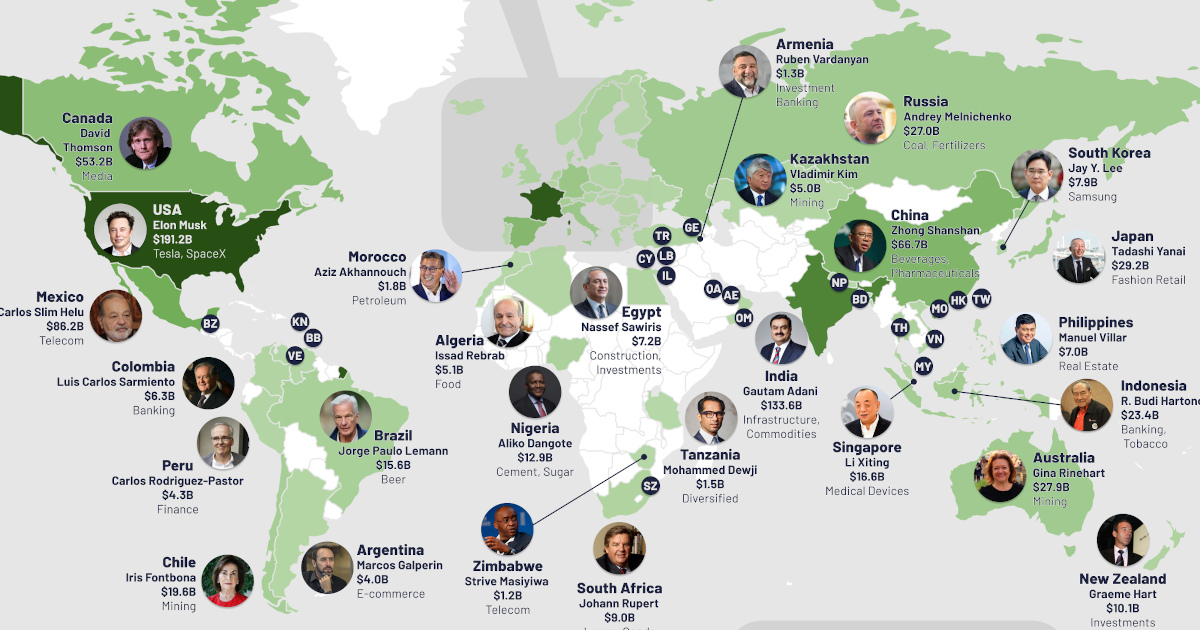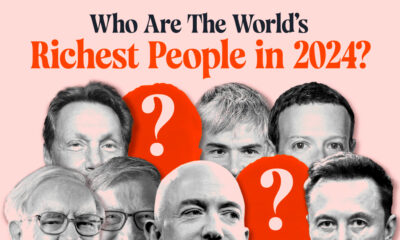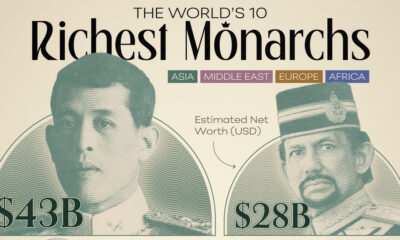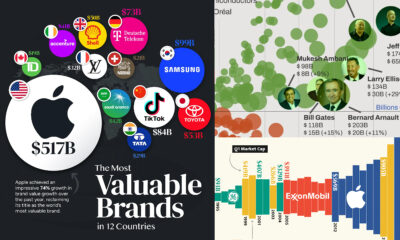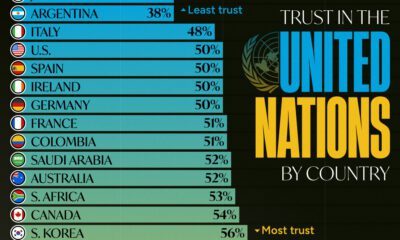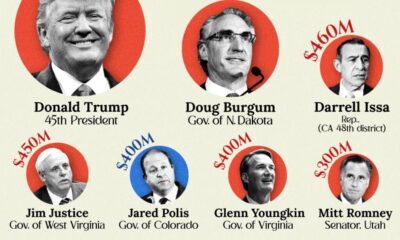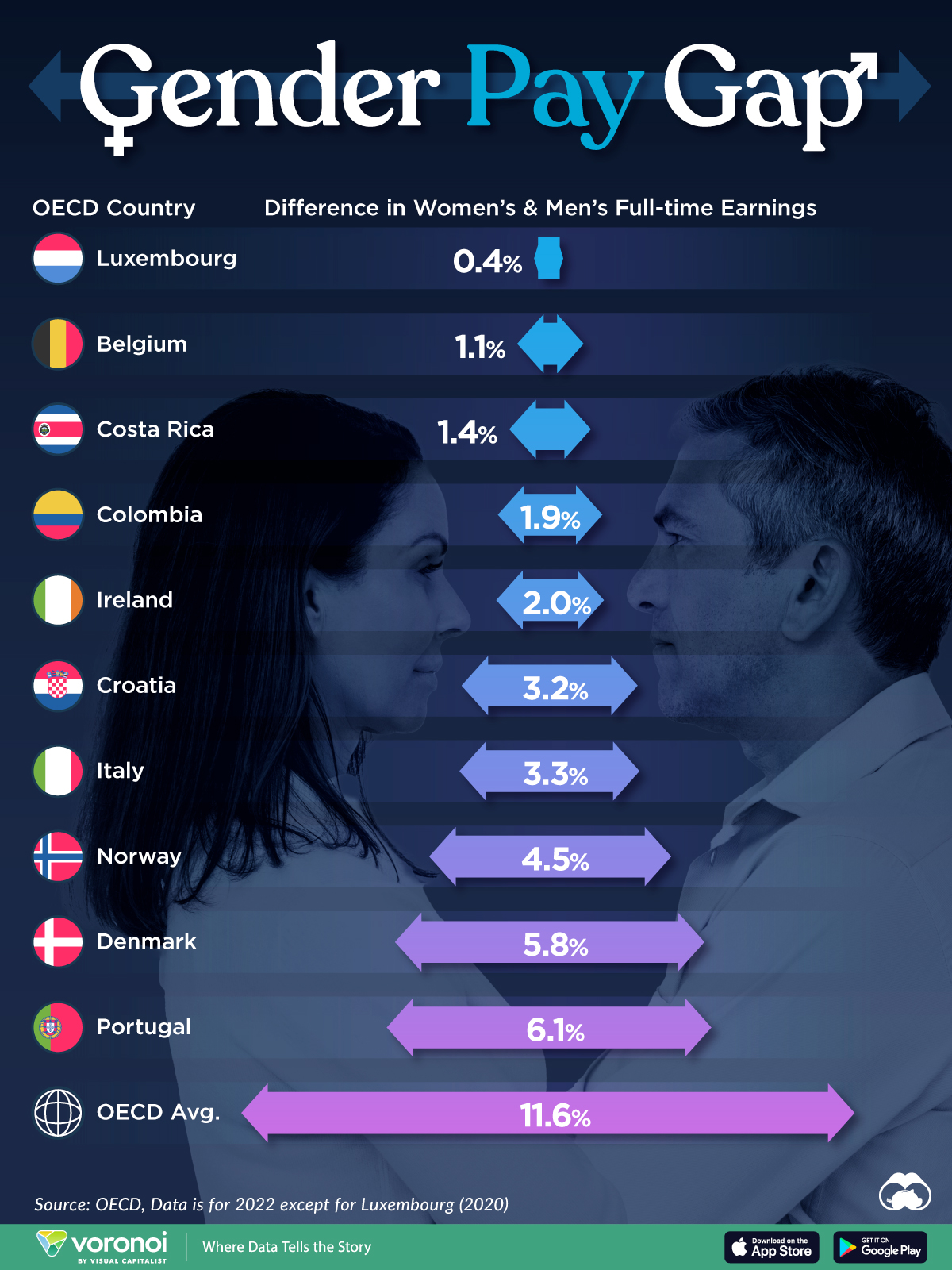Money
Mapping Out the Richest Billionaires in Each Country
Click to view a larger version of the graphic.
Mapping Out The Richest Billionaires in Each Country
While there are nearly 8 billion people in the world, just over 3,000 are billionaires as of November 2022. This tiny group of people is worth nearly $11.8 trillion—Equivalent to about 11.8% of global GDP.
Where do these billionaires live? This graphic by Truman Du uses data from Forbes to map out the richest billionaires around the world.
The Full List
As it turns out, billionaires are a lot more geographically concentrated than you might think.
In fact, of the 195 officially recognized countries around the world, only 76 are home to billionaires. And even within these countries, there’s vast disparities between the quantity of billionaires.
Here’s a breakdown of all the countries that have at least one billionaire. For countries with more than one, we’ve highlighted the billionaire with the highest net worth as of November 28, 2022:
| Country/territory | Name | Net worth ($B) | Main source of wealth (sector) |
|---|---|---|---|
| 🇩🇿 Algeria | Issad Rebrab | 5.1 | food |
| 🇦🇷 Argentina | Marcos Galperin | 4.0 | e-commerce |
| 🇦🇲 Armenia | Ruben Vardanyan | 1.3 | investment banking |
| 🇦🇺 Australia | Gina Rinehart | 27.9 | mining |
| 🇦🇹 Austria | Georg Stumpf | 7.9 | real estate, construction |
| 🇧🇩 Bangladesh | Muhammed Aziz Khan | 1.0 | power |
| 🇧🇧 Barbados | Rihanna | 1.4 | music, cosmetics |
| 🇧🇪 Belgium | Eric Wittouck | 9.0 | investments |
| 🇧🇿 Belize | Kenneth Dart | 4.0 | investments |
| 🇧🇷 Brazil | Jorge Paulo Lemann | 15.6 | beer |
| 🇧🇬 Bulgaria | Georgi & Kiril Domuschiev | 1.9 | animal health, investments |
| 🇨🇦 Canada | David Thomson | 53.2 | media |
| 🇨🇱 Chile | Iris Fontbona | 19.6 | mining |
| 🇨🇳 China | Zhong Shanshan | 66.7 | beverages, pharmaceuticals |
| 🇨🇴 Colombia | Luis Carlos Sarmiento | 6.3 | banking |
| 🇨🇾 Cyprus | John Fredriksen | 11.4 | shipping |
| 🇨🇿 Czechia | Renata Kellnerova | 16.0 | finance, telecommunications |
| 🇩🇰 Denmark | Anders Holch Povlsen | 11.9 | fashion retail |
| 🇪🇬 Egypt | Nassef Sawiris | 7.2 | construction, investments |
| 🇪🇪 Estonia | Kristo Kaarmann | 1.4 | payments, banking |
| 🇫🇮 Finland | Antti Herlin | 3.9 | elevators, escalators |
| 🇫🇷 France | Bernard Arnault | 179.5 | LVMH |
| 🇬🇪 Georgia | Bidzina Ivanishvili | 4.8 | investments |
| 🇩🇪 Germany | Beate Heister & Karl Albrecht Jr. | 35.1 | supermarkets |
| 🇬🇷 Greece | Vicky Safra | 7.1 | banking |
| 🇬🇬 Guernsey | Stephen Lansdown | 2.3 | financial services |
| 🇭🇰 Hong Kong | Li Ka-shing | 33.0 | diversified |
| 🇭🇺 Hungary | Sandor Csanyi | 1.1 | finance, real estate |
| 🇮🇸 Iceland | Thor Bjorgolfsson | 2.5 | investments |
| 🇮🇳 India | Gautam Adani | 133.6 | infrastructure, commodities |
| 🇮🇩 Indonesia | R. Budi Hartono | 23.4 | banking, tobacco |
| 🇮🇪 Ireland | John Collison & Patrick Collison | 8,1 | payments software |
| 🇮🇱 Israel | Eyal Ofer | 14.4 | real estate, shipping |
| 🇮🇹 Italy | Giovanni Ferrero | 34.4 | Nutella, chocolates |
| 🇯🇵 Japan | Tadashi Yanai | 29.2 | fashion retail |
| 🇰🇿 Kazakhstan | Vladimir Kim | 5.0 | mining |
| 🇱🇧 Lebanon | Taha Mikati | 2.8 | telecom |
| 🇱🇮 Liechtenstein | Christoph Zeller | 2.2 | dental materials |
| 🇲🇴 Macau | Hoi Kin Hong | 1.2 | real estate |
| 🇲🇾 Malaysia | Quek Leng Chan | 10.2 | banking, property |
| 🇲🇽 Mexico | Carlos Slim Helu | 86.2 | telecom |
| 🇲🇨 Monaco | Stefano Pessina | 9.3 | drugstores |
| 🇲🇦 Morocco | Aziz Akhannouch | 1.8 | petroleum |
| 🇳🇵 Nepal | Binod Chaudhary | 1.5 | diversified |
| 🇳🇱 Netherlands | Charlene de Carvalho-Heineken | 15.0 | Heineken |
| 🇳🇿 New Zealand | Graeme Hart | 10.1 | investments |
| 🇳🇬 Nigeria | Aliko Dangote | 12.9 | cement, sugar |
| 🇳🇴 Norway | Andreas Halvorsen | 6.6 | hedge funds |
| 🇴🇲 Oman | Suhail Bahwan | 2.0 | diversified |
| 🇵🇪 Peru | Carlos Rodriguez-Pastor | 4.3 | finance |
| 🇵🇭 Philippines | Manuel Villar | 7.0 | real estate |
| 🇵🇱 Poland | Michal Solowow | 6.0 | investments |
| 🇵🇹 Portugal | Maria Fernanda Amorim | 4.5 | energy, investments |
| 🇶🇦 Qatar | Faisal Bin Qassim Al Thani | 1.9 | hotels |
| 🇷🇴 Romania | Ion Stoica & Matei Zaharia | 1.6 | data analytics |
| 🇷🇺 Russia | Andrey Melnichenko | 27.0 | coal, fertilizers |
| 🇸🇬 Singapore | Li Xiting | 16.6 | medical devices |
| 🇸🇰 Slovakia | Ivan Chrenko | 1.6 | real estate |
| 🇿🇦 South Africa | Johann Rupert | 9.0 | luxury goods |
| 🇰🇷 South Korea | Jay Y. Lee | 7.9 | samsung |
| 🇪🇸 Spain | Amancio Ortega | 62.5 | Zara |
| 🇰🇳 St. Kitts and Nevis | Myron Wentz | 1.3 | health products |
| 🇸🇿 Swaziland (Eswatini) | Nathan Kirsh | 5.4 | retail, real estate |
| 🇸🇪 Sweden | Stefan Persson | 15.3 | H&M |
| 🇨🇭Switzerland | Guillaume Pousaz | 23.0 | fintech |
| 🇹🇼 Taiwan | Zhang Congyuan | 6.7 | shoes |
| 🇹🇿 Tanzania | Mohammed Dewji | 1.5 | diversified |
| 🇹🇭 Thailand | Sarath Ratanavadi | 12.2 | energy |
| 🇹🇷 Turkey | Ibrahim Erdemoglu | 6.5 | carpet |
| 🇺🇦 Ukraine | Rinat Akhmetov | 4.3 | steel, coal |
| 🇦🇪 United Arab Emirates | Pavel Durov | 15.1 | messaging app |
| 🇬🇧 United Kingdom | Michael Platt | 15.2 | hedge funds |
| 🇺🇸 United States | Elon Musk | 191.2 | Tesla, SpaceX |
| 🇻🇪 Venezuela | Juan Carlos Escotet | 3.2 | banking |
| 🇻🇳 Vietnam | Pham Nhat Vuong | 4.7 | diversified |
| 🇿🇼 Zimbabwe | Strive Masiyiwa | 1.2 | telecom |
The United States is well known to have one of the highest concentrations of billionaires. It’s home to over 900, with Elon Musk the wealthiest of them all with a staggering net worth of over $191 billion in November 2022. That makes him not just the richest billionaire in America, but the richest person in the world.
China has the second highest concentration of billionaires, with 400 ultra-wealthy that have a combined net worth of $1.45 trillion. China’s richest billionaire, Zhong Shanshan, is the founder of the Nongfu Spring beverage company.
Interestingly, there are no clear patterns when it comes to the type of industry or sector that these billionaires are involved in. The exception is the U.S., where a significant number of billionaires are linked to the tech industry.
And it’s important to note that some heads of states are reportedly billionaires, and in many cases might be the wealthiest people in their respective countries. But their wealth is often a state secret, well-diversified, and too difficult to accurately estimate.
Male vs. Female Billionaires
One trend that does stand out is the number of men versus women who are billionaires. Of the 76 billionaires on the list, only 7 are women.
This pattern is also evident when looking at the entire billionaire population—of the 3,311 billionaires worldwide, only 12.9% are women.
It’s worth mentioning that this population of billionaire women is rising. According to Forbes, the 2021 list included 328 women, 36% more than in 2020.

This article was published as a part of Visual Capitalist's Creator Program, which features data-driven visuals from some of our favorite Creators around the world.
Demographics
The Smallest Gender Wage Gaps in OECD Countries
Which OECD countries have the smallest gender wage gaps? We look at the 10 countries with gaps lower than the average.
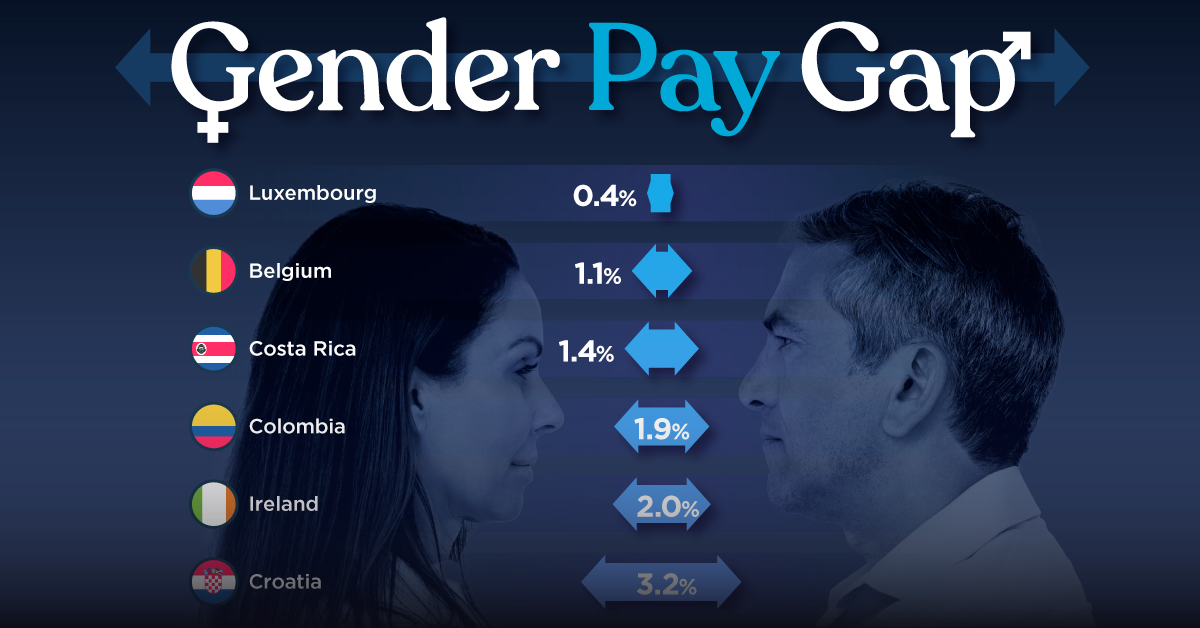
The Smallest Gender Pay Gaps in OECD Countries
This was originally posted on our Voronoi app. Download the app for free on iOS or Android and discover incredible data-driven charts from a variety of trusted sources.
Among the 38 member countries in the Organization for Economic Cooperation and Development (OECD), several have made significant strides in addressing income inequality between men and women.
In this graphic we’ve ranked the OECD countries with the 10 smallest gender pay gaps, using the latest data from the OECD for 2022.
The gender pay gap is calculated as the difference between median full-time earnings for men and women divided by the median full-time earnings of men.
Which Countries Have the Smallest Gender Pay Gaps?
Luxembourg’s gender pay gap is the lowest among OECD members at only 0.4%—well below the OECD average of 11.6%.
| Rank | Country | Percentage Difference in Men's & Women's Full-time Earnings |
|---|---|---|
| 1 | 🇱🇺 Luxembourg | 0.4% |
| 2 | 🇧🇪 Belgium | 1.1% |
| 3 | 🇨🇷 Costa Rica | 1.4% |
| 4 | 🇨🇴 Colombia | 1.9% |
| 5 | 🇮🇪 Ireland | 2.0% |
| 6 | 🇭🇷 Croatia | 3.2% |
| 7 | 🇮🇹 Italy | 3.3% |
| 8 | 🇳🇴 Norway | 4.5% |
| 9 | 🇩🇰 Denmark | 5.8% |
| 10 | 🇵🇹 Portugal | 6.1% |
| OECD Average | 11.6% |
Notably, eight of the top 10 countries with the smallest gender pay gaps are located in Europe, as labor equality laws designed to target gender differences have begun to pay off.
The two other countries that made the list were Costa Rica (1.4%) and Colombia (1.9%), which came in third and fourth place, respectively.
How Did Luxembourg (Nearly) Eliminate its Gender Wage Gap?
Luxembourg’s virtually-non-existent gender wage gap in 2020 can be traced back to its diligent efforts to prioritize equal pay. Since 2016, firms that have not complied with the Labor Code’s equal pay laws have been subjected to penalizing fines ranging from €251 to €25,000.
Higher female education rates also contribute to the diminishing pay gap, with Luxembourg tied for first in the educational attainment rankings of the World Economic Forum’s Global Gender Gap Index Report for 2023.
See More Graphics about Demographics and Money
While these 10 countries are well below the OECD’s average gender pay gap of 11.6%, many OECD member countries including the U.S. are significantly above the average. To see the full list of the top 10 OECD countries with the largest gender pay gaps, check out this visualization.
-

 Mining2 weeks ago
Mining2 weeks agoCharted: The Value Gap Between the Gold Price and Gold Miners
-

 Real Estate1 week ago
Real Estate1 week agoRanked: The Most Valuable Housing Markets in America
-

 Business1 week ago
Business1 week agoCharted: Big Four Market Share by S&P 500 Audits
-

 AI1 week ago
AI1 week agoThe Stock Performance of U.S. Chipmakers So Far in 2024
-

 Misc1 week ago
Misc1 week agoAlmost Every EV Stock is Down After Q1 2024
-

 Money2 weeks ago
Money2 weeks agoWhere Does One U.S. Tax Dollar Go?
-

 Green2 weeks ago
Green2 weeks agoRanked: Top Countries by Total Forest Loss Since 2001
-

 Real Estate2 weeks ago
Real Estate2 weeks agoVisualizing America’s Shortage of Affordable Homes


